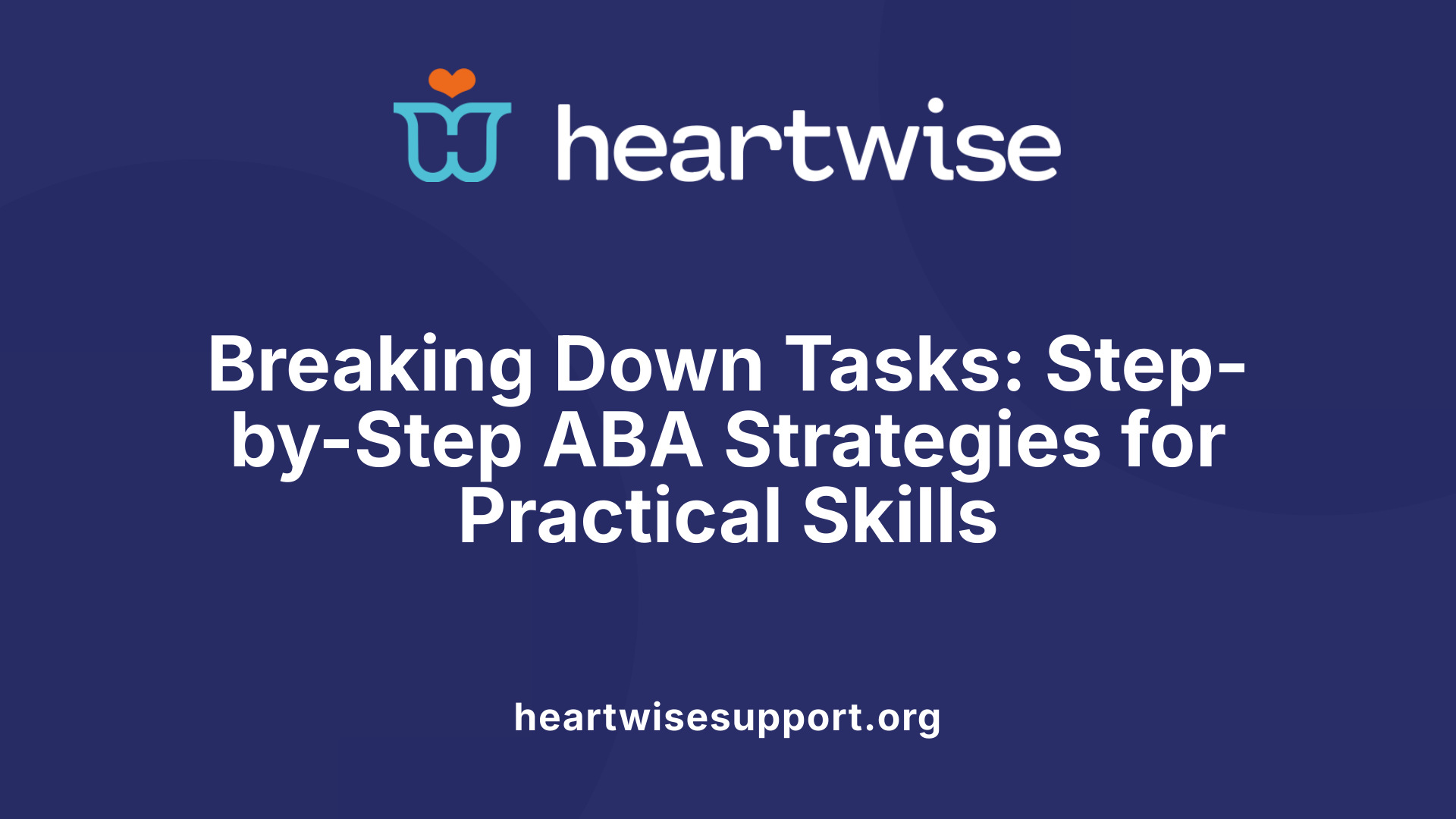Unlocking Potential with Applied Behavior Analysis
Applied Behavior Analysis (ABA) has become a cornerstone in teaching functional life skills to individuals with autism spectrum disorder (ASD). Its systematic, evidence-based approaches enable learners to acquire essential skills that foster independence, enhance daily living, and improve overall quality of life. This article explores effective techniques, curricula, and guidelines for implementing ABA strategies tailored to individual needs.
Application of ABA in Teaching Functional Skills
 Applied Behavior Analysis (ABA) plays a vital role in teaching practical life skills to individuals with autism spectrum disorder (ASD). Its techniques focus on breaking down complex, everyday tasks into small, manageable steps. For example, tasks such as brushing teeth or engaging in leisure activities are dissected into sequential actions, making them easier to learn and master.
Applied Behavior Analysis (ABA) plays a vital role in teaching practical life skills to individuals with autism spectrum disorder (ASD). Its techniques focus on breaking down complex, everyday tasks into small, manageable steps. For example, tasks such as brushing teeth or engaging in leisure activities are dissected into sequential actions, making them easier to learn and master.
Structured goals are set for each skill, often with clear benchmarks to track progress. Reinforcement strategies are carefully integrated into lessons—using praise, tokens, or preferred items—to motivate learners and encourage continuous effort. These positive stimuli help reinforce desired behaviors and foster enthusiasm for skill acquisition.
A crucial aspect of ABA is promoting the generalization of skills across different settings and situations. Whether a learner is practicing communication at home, in school, or in the community, the consistent application of learned skills ensures they become functional and adaptable. This adaptability is critical for real-world independence.
Recent advancements include the use of telehealth services, enabling remote coaching and supervision of ABA interventions. Through telehealth, trained professionals can guide caregivers and educators from afar, ensuring fidelity in implementing strategies and increasing access to effective treatment regardless of location.
Overall, ABA interventions, especially when personalized, employ methods like Natural Environment Training, Task Analysis, visual schedules, video modeling, and Discrete Trial Training to teach crucial skills. These approaches not only improve daily functioning but also significantly enhance the overall quality of life for individuals with ASD, empowering them to navigate their environments more effectively and independently.
Effective Methods and Strategies in ABA for Real-World Skills
 To effectively teach practical, everyday skills to individuals with autism spectrum disorder (ASD), Applied Behavior Analysis (ABA) employs a blend of structured and naturalistic methods. Key among these are techniques such as task analysis, prompting, and fading. Task analysis breaks down complex skills into manageable steps, facilitating systematic teaching. Prompts — cues or assistance — are used to guide learners, while fading gradually reduces their reliance, promoting independence.
To effectively teach practical, everyday skills to individuals with autism spectrum disorder (ASD), Applied Behavior Analysis (ABA) employs a blend of structured and naturalistic methods. Key among these are techniques such as task analysis, prompting, and fading. Task analysis breaks down complex skills into manageable steps, facilitating systematic teaching. Prompts — cues or assistance — are used to guide learners, while fading gradually reduces their reliance, promoting independence.
Natural Environment Training (NET) is another vital approach, emphasizing learning within real-life contexts. Instead of isolated drills, skills are embedded into routine activities like cooking, dressing, or shopping, making them more meaningful and easier to generalize across various settings.
Complementing these methods are visual aids, modeling, and role-playing. Visual schedules, social stories, and video modeling serve as visual supports that clarify expectations and demonstrate behaviors. Role-playing allows learners to practice skills in simulated real-world situations, boosting confidence and transferability.
Caregiver involvement is critical in ABA interventions. Training caregivers to implement strategies consistently in natural environments enhances skill maintenance. Reinforcing desired behaviors with praise, rewards, or preferred items increases motivation and attention during learning sessions.
Overall, integrating systematic ABA techniques with child-led, naturalistic teaching methods creates an engaging, motivating framework. This approach ensures skills are not only learned but also sustained and effectively used in daily life, greatly improving individuals' independence and quality of life.
Curricula and Resources for Teaching Life Skills
 Several targeted curricula and resources are recommended to effectively teach life skills through applied behavior analysis (ABA). Prominent among these are the ABLLS-R, AFLS, VB-MAPP, and the Complete ABA Curriculum. Each of these tools addresses essential areas such as language development, social interaction, adaptive functioning, and vocational skills, providing comprehensive frameworks tailored to individual needs.
Several targeted curricula and resources are recommended to effectively teach life skills through applied behavior analysis (ABA). Prominent among these are the ABLLS-R, AFLS, VB-MAPP, and the Complete ABA Curriculum. Each of these tools addresses essential areas such as language development, social interaction, adaptive functioning, and vocational skills, providing comprehensive frameworks tailored to individual needs.
The curricula incorporate evidence-based teaching strategies including discrete trial training (DTT), pivotal response training, incidental teaching, and natural environment teaching. These approaches promote active engagement in real-life contexts, fostering meaningful skill acquisition.
Visual supports and pictorial communication systems are vital components of ABA-based teaching. Visual schedules, activity checklists, and social stories help individuals understand routines and expectations, enhancing independence. Systems like PECS (Picture Exchange Communication System) enable learners to communicate effectively, bridging language gaps.
Structured lesson plans and assessments are integral to tracking progress and adjusting strategies. Many programs, such as Skills Streaming and STAR® Autism Support, employ detailed instructional protocols that incorporate ABA principles. These structured resources facilitate consistent delivery of lessons and enable educators to measure outcomes precisely.
Combining these curricula, visual tools, and assessments ensures that teaching is individualized and responsive. This approach supports the development of practical, essential life skills—like self-care, communication, and vocational abilities—improving everyday functioning and overall quality of life for individuals with autism.
| Curriculum/Resource | Focus Area | Special Features |
|---|---|---|
| ABLLS-R | Language, social, adaptive skills | Comprehensive assessment tool |
| AFLS | Self-care, home, community | Task analysis and visual supports |
| VB-MAPP | Language, social skills | Milestone tracking and skill assessment |
| STAR® Program | Functional routines | Discrete trial and pivotal response training |
| Visual Supports | Communication | Visual schedules, social stories, PECS |
| Assessments & Lesson Plans | Progress monitoring | Tailored, data-driven strategies |
Research Evidence Supporting ABA's Effectiveness
Numerous studies have demonstrated that applied behavior analysis (ABA) significantly enhances daily living, social, and academic skills in individuals with autism spectrum disorder (ASD). One retrospective observational study involving 16 children with ASD tracked their progress over a year, revealing notable improvements across various domains such as self-care, communication, and social interaction. The study employed systematic tools like ABA+ affective intelligence® to monitor progress, showing that targeted ABA techniques can lead to meaningful skill development.
Further research, including interventions that follow a response-to-intervention model with children aged 7 to 9, have reported substantial gains in functional communication and social skills. These programs often utilize methods like discrete trial training, natural environment training, and visual schedules, emphasizing adaptability to each child's needs.
Systematic reviews of multiple studies reinforce these findings. For example, a review of 14 research articles from 2000 to 2012 concluded that ABA-based interventions are effective in teaching essential daily skills. These studies commonly used teaching strategies like chaining, prompting, positive reinforcement, and video modeling, which proved successful across diverse settings.
Long-term assessments further support ABA’s role in promoting independence. Longitudinal studies indicate that children receiving ABA interventions develop important life skills that sustain over time, improving their overall quality of life.
Monitoring and assessment tools, such as curriculum-based evaluations and behavior tracking systems, are integral in measuring progress. These tools help tailor interventions precisely, ensuring each individual’s unique needs are met and enabling ongoing adjustments for continued growth.
In summary, research consistently highlights that ABA techniques reliably foster vital life skills in individuals with ASD, providing a foundation for improved independence and social integration.
Guidelines and Best Practices for Implementing ABA
What guidelines and best practices should be followed when implementing ABA to foster independence and daily living skills?
Implementing ABA effectively involves a strategic, evidence-based approach tailored to each individual. First, conducting thorough functional assessments is crucial for understanding a person's specific needs, strengths, and challenges. These assessments guide the development of personalized, measurable goals that focus on real-world skills such as hygiene, dressing, and cooking.
Once goals are established, systematic application of teaching techniques is essential. Methods like task analysis break down complex skills into manageable steps, while visual supports and prompts help facilitate learning. Reinforcement, both immediate and appropriately spaced, increases motivation and encourages skill acquisition. Over time, prompts are carefully faded to promote independent performance.
Consistent data collection and progress monitoring form the backbone of effective ABA interventions. Regularly tracking data allows for objective assessment of progress, helping practitioners adjust strategies promptly to maximize learning outcomes.
Family and caregiver involvement significantly enhances the success of interventions. Training families on strategies and providing them with tools to incorporate skills into daily routines ensures that learning continues outside of therapy sessions and that behaviors are reinforced in natural environments.
Additionally, ABA programs should incorporate transition planning, safety education, and opportunities for community involvement. These components support sustainable independence, helping individuals navigate various settings confidently and safely.
Overall, adhering to these guidelines helps create a structured, supportive environment conducive to meaningful skill development and increased independence.
Fostering Autonomous Living through Evidence-Based Practice
Applying ABA techniques for teaching functional life skills is a proven approach that emphasizes individualization, systematic teaching, and real-world relevance. When combined with effective curricula, ongoing assessment, and caregiver involvement, ABA fosters independence and improves daily functioning for individuals with autism. Staying abreast of current research and best practices ensures that interventions remain effective and responsive to learners’ evolving needs, ultimately supporting a meaningful and autonomous life.
References
- Treating adaptive living skills of persons with autism using applied ...
- Life Skills in ABA - Project Play Therapy
- [PDF] Functional and Life Skills Curriculum for Individuals on the Autism ...
- Functional Skills in ABA: An Overview
- Telehealth to train interventionists teaching functional living skills to ...
- ABA and Naturalistic Teaching: Learning in Real-World Settings
- 10 Ways ABA Therapy Can Help with Life Skills











